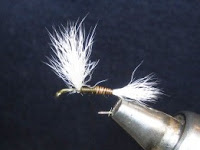The H and L Variant is one of the great dry fly attractor patterns. This highly visible dry fly floats well, can be seen well in low light conditions and trout eat the heck out of it. I like to use a size #10, #12, or #14 when tying this fly. I find that an H and L works best in fast rivers when there are lots of caddis and mayflies hatching, or anywhere on the Frying Pan River.
Watch how to tie this fly:
~ Click on any image to enlarge ~
Materials List:
You can expect this H&L to get lots of bites. I suggest using a strong dry fly hook that won't bend out.
I like to use a thread that is strong, but not too bulky when I tie hair wing dry flies like this one. Danville's FlyMaster is a good choice.
The wings of this dry fly pattern are tied with Calf Body Fur. This material is very visible even in low light situations.
Both the body and the collar of this fly are tied with peacokc hurl.
Finally, the hackle of an H & L Variant is tied with a couple of stout brown saddle hackles.
Click here to buy Brown Saddle Hackles
~ Click on any image to enlarge ~
Click here to buy Brown Saddle Hackles
~ Click on any image to enlarge ~
Step By Step: How to tie an H and L Variant Dry Fly
Start the hook with thread and leave it at the midpoint of the shank.
Stack the tips of a clump of calf body fur and tie them in, tips forward for the wing of the fly.
Now part the calf body fur and separate the wings with thread. I use a figure 8 wrap and often a few wraps around each wing. Be sure not to use too much thread. Here is a view from the top of the top.
Tie in the tail of the fly by stacking another clump of calf body fur.
The body of this fly is tied by stripping a peacock hurl and wrapping it forward about 1/3rd of the way to the eye.
Next, wrap two or three turns of regular peacock hurl for the collar of the fly.
Finally, tie in two stout brown saddle hackles. Wrap the hackles both in front and behind the wings and complete the fly with a few tight whip finishes.
H and L Variant Dry Fly
Dry Fly fishing in Colorado is fantastic, especially around the Aspen area. The rivers here are full of hungry trout that love to eat dries. The best time of year to catch fish on dry flies is July, August and September. If you would like to experience what dry fly fishing should be, go to http://www.aspenflyfishing.com and book a guided float trip.















This is a grreat blog
ReplyDelete